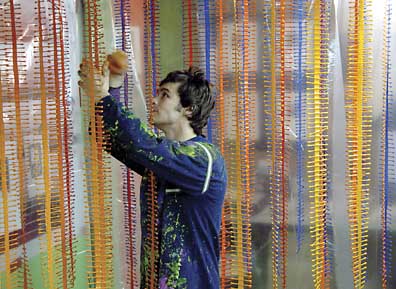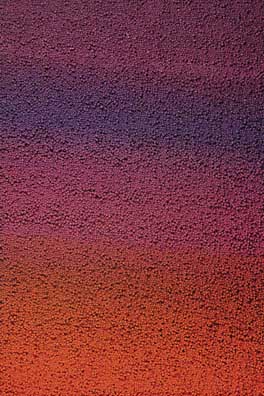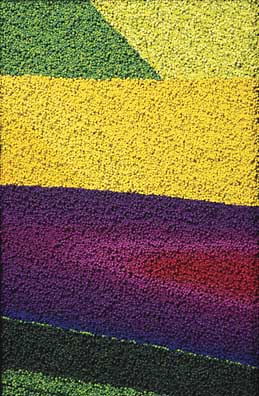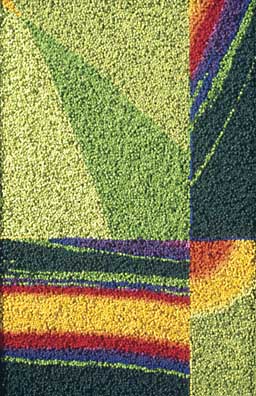
Ryan Bown at work hanging painted Q-Tips for drying
Current Issue Highlights More Readings DA Home About Direct Art

Ryan Bown at work hanging painted Q-Tips for drying
By Brian Christensen
Edited by Chelsea D. Davis
What do 52,000 Q-tips, fractal theory, and pointillist methodology have in common? Ryan Bown, an exciting, young, conceptual artist working in Provo, Utah, makes the connection for us. Using his scientific background as a springboard, Bown composes large-scale paintings from thousands of individually painted Q-tips in a remarkably unique and labor-intensive process with mind-boggling results. More than simply style or a formal concern, Bown’s art asks basic questions about the foundations of existence through examination of the genetic code, fractal geometry, and other numerical disciplines. In a recent interview in Bown’s studio, we discussed his art and the analogies it draws from science and life.
Brain Christensen: When I was at your last solo show, entitled RXN, I was first struck by the methodical nature of the presentation. The paintings and installations seemed to be derived from various aspects of science. How has science come to play such an important role in your work?
Ryan Bown: My grandfather and father were both scientists. I can remember when I was a little kid, about six or so, that on the weekends, my father would sit at the kitchen table, which was covered in papers. There were long formulas all over the place, but what I was most intrigued by was his big calculator. There was a fascination that came from seeing him push buttons, and after a few minutes, a picture would come up on the screen. He would then write down a long number. Frankly, I had no idea what he was doing. I was only interested in the calculator. It was like some super Etch-a-Sketch. Since then, I have been obsessed with images generated from numeric values.
BC: I can see your early fascination with scientific process. Did you always want to be an artist?
RB: I did. I never got to use my father’s calculator and did not purchase one with that picture capability until much later, so I began painting. Some people were convinced that I would pursue a career in science because I used to wear a lab coat as an art smock in high school.

600X a 26000 individually painted cotton swabs
48" x 36" x 3"
BC: What generated the idea of using Q-tips in a pointillist manner?
RB: During the summer of 2002, I helped my brother Dave work on Self Portrait III, an 8' x 3.5' work constructed of bubble wrap. The 20,000- plus bubbles were individually filled with paint using medical syringes. I witnessed each bubble come to life as the paint filled each cavity. To me, the bubbles became cells. The process of growth and life fascinated me. I searched to find a method of illustrating this progressive characteristic in my work. The process needed to be directly connected to the idea, and I was interested in finding something that I could get more detail with than the bubbles. After a process of elimination and luck, I selected Q-tips. There was much time and research dedicated to developing the most effective technique to paint, dry, and secure the Q-tips. Two weeks and five hundred hours later. Mitosis 1 was completed.
BC: Ryan, 14 days at 24 hours each day is 336 hours. Mathematically, is that not impossible?
RB: I had a lot of help. A few of the artisans were Cindy, Cyd, Dave, Delos, Sheila and Stasha Bown, Lisa Covington, Jen and Cory Farr, Joel Johnson, and Mark Willison, They assisted in painting, cutting, and gluing Q-tips in designated areas.
BC: One reviewer has dubbed your method, "Seurat meets Johnson & Johnson," but you stylistically and philosophically align yourself more with Chuck Close. What is your attraction to Close?
RB: While my newer work has left the realm of representational portraiture, I still feel that I share a similar system of ideas and attitudes with Close towards creating new art. One friend, knowing that I like Close’s work gave me a list of quotes from him that I enjoy and find amusing. "I wish I had the exact quote, but in essence Greenburg said, ‘The one thing you can’t do in art anymore is make a portrait.’ And then de Kooning said, ‘Yeah. And you can’t help but make one,’ or something to that effect. I remember that as the gauntlet being thrown down by Greenburg. It’s as if Greenburg had said, ‘This is the one thing you can’t do.’ Then I thought, fuck ‘em. I’m going to find a way to do it."

600X b 26000 individually painted cotton swabs
48" x 36" x 3"
BC: Nick Battis, the Assistant Director of Exhibitions at Pratt Institute New York City, New York, writes about your work, "The fractured portraits...focus on the uniqueness of the individual by segmenting their (his) portraits and making us focus on the details.. . Similarly, Ryan Bown achieves his own self-portrait, titled "Mitosis," by assembling 52,000 Q-tips, pigmented with various shades of black, white, and gray." Daneyal Mahmood and Erica Love of Kashya Hildebrand Gallery in New York City, New York, also write, "Ryan Bown is obsessed with both constructing and deconstructing the act of painting. It is a precocious preoccupation for such a young artist. Comprised of densely placed, hand-painted Q-tips, Bawn’s paintings act as a visual record to cells in movement. Like great optical art, Bown’s paintings question the inherent staid quality of a painting. It is possible that the Q-tip cells are in a constant movement that is undetected by the human eye. Bown’s intermingling of imagery and materiality through a systemic obsessiveness is exciting and dynamic."
Do these kinds of statements sum up the essence of what you are trying to convey to the viewer?
RB: I think both of these statements are accurate portrayals of what the work is saying. The first statement is in reference to the Mitosis portrait series, and the second is referring to the 600X fractal series. However, that was not the essence of what I was trying to say with Mitosis. For that reason and others, the work evolved.
BC: Your Q-tip paintings have gone through a metamorphosis from portraits to minimalist compositions and finally to fractal-based abstraction. Could you talk about these transitions and their implications in your work?
RB: Last fall I had a show with my brother Dave and my sister Cyd at the Cowan Gallery in Orem, Utah, and I was showing Mitosis I, II, and III. After it was decided where things would be placed, there was one unused wall. Two weeks before the show, I decided to make some smaller (12" x 12") Q-tip paintings out of the leftover painted Q-tips from the portraits. With not much time, I decided to branch into the abstract. I took the previously mentioned Q-tips, placed them in a bag, and whatever color I drew out, I glued in. This lack of order was the polar opposite of Mitosis. This random placement was completely spontaneous, and I entitled the series Cancer. While building Cancer II, I could see that I was sure to run out of the mixture before I could complete the piece. I mapped out a geometric shape and dipped a new mixture for the rectangular cavity. Imposing this shape brought order again into a field of disorder. Cancer II became the most interesting visually to others and me. A few months later, I had a private critique with Professor Joseph Ostraff. Joe examined the Cancer series and recommended that I study chaos theory.
BC: I was intrigued during our last conversation by your interpretation of the relationship and dichotomy of order and chaos. Could you place these concepts into the context of your work?
RB: A cell’s movement is a reaction to how other cells are moving around them. Due to the fact that cells life functions are not derived from linear equations, their movements can not be predicted with exactness. While observing patterns of a system, scientists and mathematicians will insert numeric values that represent cell positioning in the group into formulas to study the behavior and characteristics of order in the midst of apparent disorder. In other words, when the critical eye traces the cell’s movement, an image classified as a fractal will be produced. One Q-tip represents one cell. When viewing a human cell under a microscope that has been magnified 600 times, the diameter of a painted Q-tip head is approximately the same size as a cell. The images are visual translations that are derived from chaotic formulas, abstract images that capture the dynamic movement of cell groups.

600X c 26000 individually painted cotton swabs
48" x 36" x 3"
BC: Your fractal-based paintings seem to enforce the beauty of nonobjective observation and orderly classification. Is beauty essential to your art?
RB: If you are using the term beauty in a nonrepresentational and socially-driven sense, then, yes. I think the image generated should be visually pleasing, and I think the reason that the images are pleasing to look at is because they are based on fractals. Benoit Manddbort believed that fractals could be found nearly anywhere in nature, so when you see an image that has been generated based on fractal geometry, your mind relates to what it sees in nature at a micro level.
BC: How did you arrive at your fractal images?
RB: Now that I have the big calculator to make the cool pictures, I use a program in which I insert numeric values into a formula that generates an image.
BC: Where do you see your work going from here?
RB: I plan to vary the topography of a piece and to have them become freestanding sculptures.
BC: Are there any artists or individuals that have influenced your work?
RB: Chuck Close, Franz Spohn, and Joe Zucker. However, numerous other individuals had influenced my work through critiques and studio visits. The critiques by my professors and visiting artists have propelled my work in a progressive direction. An honest critique does not cause you to suddenly change what you were doing. However, I think honest criticism when taken the right way will help you do what you might not have attempted for another few years.
BC: What do you really want a viewer to get out of your art, and what is the audience you are trying to target?
RB: My work is not for just one group in particular. However, I design my work to reward those that take the time to conduct intense examination of the piece.

Mitosis III (detail) Individually painted cotton
swabs 48" x 36" x 3"
Current Issue Highlights More Readings DA Home About Direct Art